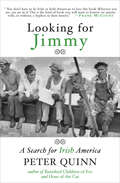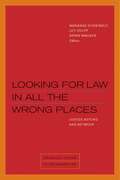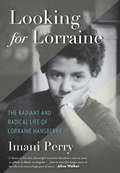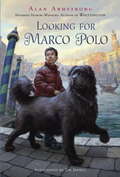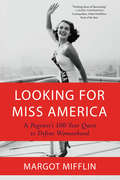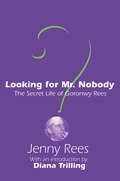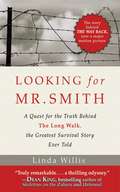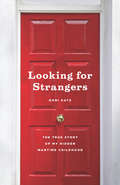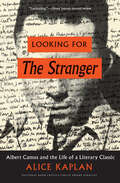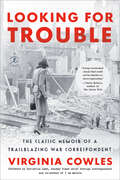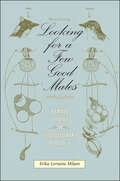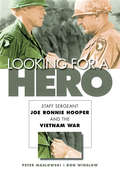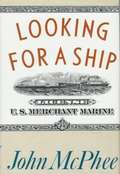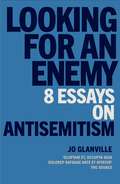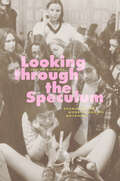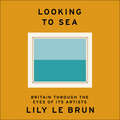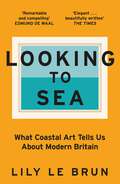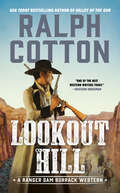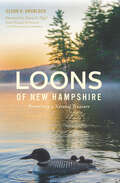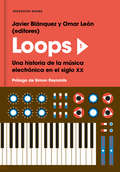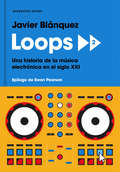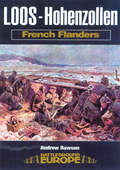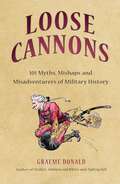- Table View
- List View
Looking for Jimmy: A Search for Irish America
by Peter QuinnIn this stunning work chronicling the author’s exploration of his own past—and the lives of many hundreds of thousands of nameless immigrants who struggled alongside his own ancestors—Peter Quinn paints a brilliant new portrait of the Irish-American men a In Quinn’s hands, the Irish stereotype of “Paddy” gives way to an image of “Jimmy”—an archetypal Irish-American (a composite of Jimmy Cagney and Jimmy Walker) who comes to life as a fast-talking, tough-yet-refined urban American redefining American politics, street culture, religion, and imagination. From their immigration into America to the politics of the modern day, Quinn's vibrant prose weaves together the story of a people that has made an immeasurable contribution to American history and culture.
Looking for Law in All the Wrong Places: Justice Beyond and Between (Berkeley Forum in the Humanities)
by Wendy Brown Saba Mahmood Daniel Boyarin Christopher Tomlins Samera Esmeir Ramona Naddaff Kathryn Abrams Sara Ludin Sarah Song Rebecca M. McLennan Bath H. Piatote Daniel FisherFor many inside and outside the legal academy, the right place to look for law is in constitutions, statutes, and judicial opinions. This book looks for law in the “wrong places”—sites and spaces in which no formal law appears. These may be geographic regions beyond the reach of law, everyday practices ungoverned or ungovernable by law, or works of art that have escaped law’s constraints.Looking for Law in All the Wrong Places brings together essays by leading scholars of anthropology, cultural studies, history, law, literature, political science, race and ethnic studies, religion, and rhetoric, to look at law from the standpoint of the humanities. Beyond showing law to be determined by or determinative of distinct cultural phenomena, the contributors show how law is itself interwoven with language, text, image, and culture.Many essays in this volume look for law precisely in the kinds of “wrong places” where there appears to be no law. They find in these places not only reflections and remains of law, but also rules and practices that seem indistinguishable from law and raise challenging questions about the locations of law and about law’s meaning and function. Other essays do the opposite: rather than looking for law in places where law does not obviously appear, they look in statute books and courtrooms from perspectives that are usually presumed to have nothing to say about law.Looking at law sideways, or upside down, or inside out defamiliarizes law. These essays show what legal understanding can gain when law is denied its ostensibly proper domain.Contributors: Kathryn Abrams, Daniel Boyarin, Wendy Brown, Marianne Constable, Samera Esmeir, Daniel Fisher, Sara Ludin, Saba Mahmood, Rebecca McLennan, Ramona Naddaff, Beth Piatote, Sarah Song, Christopher Tomlins, Leti Volpp, Bryan Wagner
Looking for Lorraine: The Radiant and Radical Life of Lorraine Hansberry
by Imani PerryA revealing portrait of one of the most gifted and charismatic, yet least understood, Black artists and intellectuals of the twentieth century. <p><p> Lorraine Hansberry, who died at thirty-four, was by all accounts a force of nature. Although best-known for her work A Raisin in the Sun, her short life was full of extraordinary experiences and achievements, and she had an unflinching commitment to social justice, which brought her under FBI surveillance when she was barely in her twenties. While her close friends and contemporaries, like James Baldwin and Nina Simone, have been rightly celebrated, her story has been diminished and relegated to one work—until now. <p> In 2018, Hansberry will get the recognition she deserves with the PBS American Masters documentary “Lorraine Hansberry: Sighted Eyes/Feeling Heart” and Imani Perry’s multi-dimensional, illuminating biography, Looking for Lorraine. <p> After the success of A Raisin in the Sun, Hansberry used her prominence in myriad ways: challenging President Kennedy and his brother to take bolder stances on Civil Rights, supporting African anti-colonial leaders, and confronting the romantic racism of the Beat poets and Village hipsters. Though she married a man, she identified as lesbian and, risking censure and the prospect of being outed, joined one of the nation’s first lesbian organizations. Hansberry associated with many activists, writers, and musicians, including Malcolm X, Langston Hughes, Duke Ellington, Paul Robeson, W.E.B. Du Bois, among others. <p> Looking for Lorraine is a powerful insight into Hansberry’s extraordinary life—a life that was tragically cut far too short.
Looking for Marco Polo
by Alan ArmstrongNewbery Honor-winning author Alan Armstrong's latest book! Eleven-year-old Mark's anthropologist father has disappeared in the Gobi desert while tracing Marco Polo's ancient route from Venice to China. His mother decides they must go to Venice to petition the agency that sent Mark's father to send out a search party. Anxious about his father and upset about spending Christmas away from home, Mark gets a bad asthma attack in the middle of the night. That's when Doc Hornaday, an old friend of Mark's father, makes a house call, along with a massive black Tibetan mastiff called Boss. To distract Mark from his wheezing and to pass the long Venetian night, the Doc starts to spin for Mark the tale of Marco Polo. Doc describes Marco's travels and the boy finds himself falling under the spell of the story that has transfixed the world for centuries. Marco's journey bolsters Mark's courage and whets his appetite for risk and adventure, and for exposure to life in all its immense and fascinating variety. From the Hardcover edition.
Looking for Miss America: A Pageant's 100-Year Quest to Define Womanhood
by Margot MifflinFrom an author praised for writing “delicious social history” (Dwight Garner, The New York Times) comes a lively account of memorable Miss America contestants, protests, and scandals—and how the pageant, nearing its one hundredth anniversary, serves as an unintended indicator of feminist progressLooking for Miss America is a fast–paced narrative history of a curious and contradictory institution. From its start in 1921 as an Atlantic City tourist draw to its current incarnation as a scholarship competition, the pageant has indexed women’s status during periods of social change—the post–suffrage 1920s, the Eisenhower 1950s, the #MeToo era. This ever–changing institution has been shaped by war, evangelism, the rise of television and reality TV, and, significantly, by contestants who confounded expectations.Spotlighting individuals, from Yolande Betbeze, whose refusal to pose in swimsuits led an angry sponsor to launch the rival Miss USA contest, to the first black winner, Vanessa Williams, who received death threats and was protected by sharpshooters in her hometown parade, Margot Mifflin shows how women made hard bargains even as they used the pageant for economic advancement. The pageant’s history includes, crucially, those it excluded; the notorious Rule Seven, which required contestants to be “of the white race,” was retired in the 1950s, but no women of color were crowned until the 1980s.In rigorously researched, vibrant chapters that unpack each decade of the pageant, Looking for Miss America examines the heady blend of capitalism, patriotism, class anxiety, and cultural mythology that has fueled this American ritual.
Looking for Mr. Nobody: The Secret Life of Goronwy Rees (Phoenix Giants Ser.)
by Jenny ReesGoronwy Rees (1909-1979) was one of the most gifted and promising figures in the constellation of British poets, journalists, and intellectuals of the 1930s that included Louis MacNeice, W. H., Auden, C. Day Lewis, Isaiah Berlin, and Anthony Blunt. Like many liberals of his generation, he was shocked by the effects of the Depression and correspondingly sympathetic to the Communist regime in Russia. Guy Burgess, of the Cambridge spies--Burgess, Maclean, Philby, and Blunt, admitted his espionage to Rees. His association with Burgess was to blight the rest of Rees's life. When Burgess defected in 1951, and Rees denounced him to MI5, Rees was viewed more as a spy out to save his own skin than as an honorable citizen. His anonymous, sensationalist articles in The People, denouncing Burgess's political activities and all but naming names, condemned him with the British intellectual community--not for his politics but for his betrayal of a friend. Colleagues and acquaintances accused him of trying to initiate a McCarthyite witch-hunt. He lost his job. His academic career was ruined. In Looking for Mr. Nobody, Jenny Rees deals with many of the old charges made against her father in her search for the answer to her own question, "Was he, too, a spy?" Had he joined up with Burgess and Blunt and passed secrets to the Soviet Union? Her quest for the truth reveals a fascinating portrait of a brilliant but flawed man of letters, handsome and seductively charming, caught up in the radical, political commitments of the 1930s, Communist Party membership, and his tortured relationship with the notorious Cambridge spies.
Looking for Mr. Smith
by Linda WillisSince 1956, The Long Walk has been, for many, the symbol of an immense love of freedom and has become one of the greatest true-life adventure stories of all time. The harrowing story about a group of POWs who escaped a labor camp in Siberia and walked to freedom in India during WWII deeply affected thousands of its readers, and Linda Willis was one of those moved by the story. But she had questions about its authenticity: Was it all true? What happened after their arrival in India? Were there others involved in the story? Who was Mr. Smith? Though she was not a trained researcher, Willis felt compelled to look at some of the most powerful aspects of the story and to try to dig to the core of the truth behind The Long Walk. Willis's investigation took her down unforeseen byways with many hours spent unraveling facts, truths, half-truths, rumors, and the like. She waded through archives, wrote and spoke to hundreds of people, and continued to seek out and verify the details of the greatest adventure narrative ever written. The path of Willis's research will be a model for anyone attempting a similar search and who has ever thought about the story behind a book. No one who reads Looking for Mr. Smith will ever think of The Long Walk in the same way.
Looking for Strangers: The True Story of My Hidden Wartime Childhood
by Dori KatzDori Katz is a Jewish Holocaust survivor who thought that her lost memories of her childhood years in Belgium were irrecoverable. But after a chance viewing of a documentary about hidden children in German-occupied Belgium, she realized that she might, in fact, be able to unearth those years. Looking for Strangers is the deeply honest record of her attempt to do so, a detective story that unfolds through one of the most horrifying periods in history in an attempt to understand one’s place within it.In alternating chapters, Katz journeys into multiple pasts, setting details from her mother’s stories that have captivated her throughout her life alongside an account of her own return to Belgium forty years later—against her mother’s urgings—in search of greater clarity. She reconnects her sharp but fragmented memories: being sent by her mother in 1943, at the age of three, to live with a Catholic family under a Christian identity; then being given up, inexplicably, to an orphanage in the years immediately following the war. Only after that, amid postwar confusion, was she able to reconnect with her mother. Following this trail through Belgium to her past places of hiding, Katz eventually finds herself in San Francisco, speaking with a man who claimed to have known her father in Auschwitz—and thus known his end. Weighing many other stories from the people she meets along her way—all of whom seem to hold something back—she attempts to stitch thread after thread into a unified truth, to understand the countless motivations and circumstances that determined her remarkable life.A story at once about self-discovery, the transformation of memory, a fraught mother-daughter relationship, and the oppression of millions, Looking for Strangers is a book of both historical insight and imaginative grasp. It is a book in which the past, through its very mystery, becomes alive, immediate—of the most urgent importance.
Looking for The Stranger: Albert Camus and the Life of a Literary Classic
by Alice KaplanA New York Times Notable Book. A literary exploration that is &“surely destined to become the quintessential companion to Camus&’s most enduring novel&” (PopMatters). The Stranger is a rite of passage for readers around the world. Since its publication in France in 1942, Camus&’s novel has been translated into sixty languages and sold more than six million copies. It&’s the rare novel that&’s as likely to be found in a teen&’s backpack as in a graduate philosophy seminar. If the twentieth century produced a novel that could be called ubiquitous, The Stranger is it. How did a young man in his twenties who had never written a novel turn out a masterpiece that still grips readers more than seventy years later? With Looking for The Stranger, Alice Kaplan tells that story. In the process, she reveals Camus&’ achievement to have been even more impressive—and more unlikely—than even his most devoted readers knew. &“To this new project, Kaplan brings equally honed skills as a historian, literary critic, and biographer . . . Reading The Stranger is a bracing but somewhat bloodless experience. Ms. Kaplan has hung warm flesh on its steely bones.&” —The New York Times &“For American readers, few French novels are better known, and few scholars are better qualified than Kaplan to reintroduce us to it . . . Kaplan tells this story with great verve and insight, all the while preserving the mystery of its creation and elusiveness of its meaning.&” —Los Angeles Review of Books &“The fascinating story behind Albert Camus&’ coldblooded masterpiece . . . A compelling companion to a novel that has stayed strange.&” —Kirkus Reviews
Looking for Trouble: The Classic Memoir of a Trailblazing War Correspondent
by Virginia CowlesThe rediscovered memoir of an American gossip columnist turned &“amazingly brilliant reporter&” (The New York Times Book Review) as she reports from the frontlines of the Spanish Civil War and World War II&“A long-overlooked classic that could not be timelier or more engrossing.&”—Paula McLain, author of The Paris WifeForeword by Christina Lamb, Sunday Times chief foreign correspondent and co-author of I Am Malala Virginia Cowles was just twenty-seven years old when she decided to transform herself from a society columnist into a foreign press correspondent. Looking for Trouble is the story of this evolution, as Cowles reports from both sides of the Spanish Civil War, London on the first day of the Blitz, Nazi-run Munich, and Finland&’s bitter, bloody resistance to the Russian invasion. Along the way, Cowles also meets Adolf Hitler (&“an inconspicuous little man&”), Benito Mussolini, Winston Churchill, Martha Gellhorn, and Ernest Hemingway. Her reportage blends sharp political analysis with a gossip columnist&’s chatty approachability and a novelist&’s empathy. Cowles understood in 1937—long before even the average politician—that Fascism in Europe was a threat to democracy everywhere. Her insights on extremism are as piercing and relevant today as they were eighty years ago.
Looking for a Few Good Males: Female Choice in Evolutionary Biology (Animals, History, Culture)
by Erika L. Milam2010 Outstanding Academic Title, Choice MagazineWhy do female animals select certain mates, and how do scientists determine the answer? In considering these questions, Erika Lorraine Milam explores the fascinating patterns of experiment and interpretation that emerged as twentieth-century researchers studied sexual selection and female choice. Approaching the topic from both biological and animal-studies perspectives, Milam not only presents a broad history of sexual selection—from Darwin to sociobiology—but also analyzes the animal-human continuum from the perspectives of sex, evolution, and behavior. She asks how social and cultural assumptions influence human-animal research and wonders about the implications of gender on scientific outcomes. Although female choice appears to be a straightforward theoretical concept, the study of sexual selection has been anything but simple. Scientists in the early twentieth century investigated female choice in animals but did so with human social and sexual behavior as their ultimate objective. By the 1940s, evolutionary biologists and population geneticists shifted their focus, studying instead how evolution affected natural animal populations. Two decades later, organismal biologists once again redefined the investigation of sexual selection as sociobiology came to dominate the discipline.Outlining the ever-changing history of this field of study, Milam uncovers lost mid-century research programs and finds that the discipline did not languish in the decades between Darwin’s theory of sexual selection and sociobiology, as observers commonly believed. Rather, population geneticists, ethologists, and organismal biologists alike continued to investigate this important theory throughout the twentieth century.
Looking for a Hero: Staff Sergeant Joe Ronnie Hooper and the Vietnam War
by Don Winslow Peter MaslowskiWidely acclaimed as the Vietnam War's most highly decorated soldier, Joe Ronnie Hooper in many ways serves as a symbol for that conflict. His troubled, tempestuous life paralleled the upheavals in American society during the 1960s and 1970s, and his desperate quest to prove his manhood was uncomfortably akin to the macho image projected by three successive presidents in their "tough" policy in Southeast Asia. Looking for a Hero extracts the real Joe Hooper from the welter of lies and myths that swirl around his story; in doing so, the book uncovers not only the complicated truth about an American hero but also the story of how Hooper's war was lost in Vietnam, not at home. Extensive interviews with friends, fellow soldiers, and family members reveal Hooper as a complex, gifted, and disturbed man. They also expose the flaws in his most famous and treasured accomplishment: earning the Medal of Honor. In the distortions, half-truths, and outright lies that mar Hooper's medal of honor file, authors Peter Maslowski and Don Winslow find a painful reflection of the army's inability to be honest with itself and the American public, with all the dire consequences that this dishonesty ultimately entailed. In the inextricably linked stories of Hooper and the Vietnam War, the nature of that deceit, and of America's defeat, becomes clear.
Looking for a Ship
by John McpheeThis is an extraordinary tale of life on the high seas aboard one of the last American merchant ships, the S. S. Stella Lykes, on a forty-two-day journey from Charleston down the Pacific coast of South America. With his usual interest in everything and everybody, John McPhee tells a wide-ranging story of the U.S. Merchant Marine, the ships that are a part of it, and the people who work the ships, the history and geology of the places he sees, sea tales, pirates, and the amazing variety of products that are carried by freighters.
Looking for an Enemy: 8 Essays on Antisemitism
by Jo Glanville<p>"Like all the best meetings of Jewish minds, this book will make you think, argue and see the world anew." Hadley Freeman, author of House of Glass<p> <p>Conspiracy theories about Jews are back in the mainstream. The Pittsburgh gunman who murdered 11 people in a synagogue claimed that 'filthy evil' Jews were bringing 'filthy evil' Muslims into America. The billionaire philanthropist George Soros has been accused of supporting 'white genocide'. Labour Party members have claimed that Israel is behind ISIS.<p> <p>The belief that Jews are plotting against society never dies, it just adapts to suit the times: from medieval accusations that Jews murder Christians for their blood to claims that Zionists are seeking to control the world.<p> <p>In eight short essays, edited by Jo Glanville, this book goes back to the source of the conspiracy theories and traces their journey into the 21st century in a bid to make sense of their survival.<p> <p>With contributions from some of the great Jewish writers and thinkers of our time, including Tom Segev, Jill Jacobs and Mikhail Grynberg, this is a fresh take on the roots of antisemitism that explores how an irrational belief can still flourish in a supposedly rational age.<p>
Looking for the Good War: American Amnesia and the Violent Pursuit of Happiness
by Elizabeth D. Samet"Essential reading. This eloquent, far-ranging analysis of the national psyche goes as far as any book I've ever read toward explaining the peculiar American yen for war and more war." —Ben Fountain, author of Billy Lynn's Long Halftime Walk and Beautiful Country Burn AgainIn Looking for the Good War, Elizabeth D. Samet reexamines the literature, art, and culture that emerged after World War II, bringing her expertise as a professor of English at West Point to bear on the complexity of the postwar period in national life. She exposes the confusion about American identity that was expressed during and immediately after the war, and the deep national ambivalence toward war, violence, and veterans—all of which were suppressed in subsequent decades by a dangerously sentimental attitude toward the United States’ “exceptional” history and destiny. Samet finds the war's ambivalent legacy in some of its most heavily mythologized figures: the war correspondent epitomized by Ernie Pyle, the character of the erstwhile G.I. turned either cop or criminal in the pulp fiction and feature films of the late 1940s, the disaffected Civil War veteran who looms so large on the screen in the Cold War Western, and the resurgent military hero of the post-Vietnam period. Taken together, these figures reveal key elements of postwar attitudes toward violence, liberty, and nation—attitudes that have shaped domestic and foreign policy and that respond in various ways to various assumptions about national identity and purpose established or affirmed by World War II.As the United States reassesses its roles in Afghanistan and the Middle East, the time has come to rethink our national mythology: the way that World War II shaped our sense of national destiny, our beliefs about the use of American military force throughout the world, and our inability to accept the realities of the twenty-first century’s decades of devastating conflict.
Looking through the Speculum: Examining the Women’s Health Movement
by Judith A. HouckHighlights local history to tell a national story about the evolution of the women’s health movement, illuminating the struggles and successes of bringing feminist dreams into clinical spaces. The women’s health movement in the United States, beginning in 1969 and taking hold in the 1970s, was a broad-based movement seeking to increase women’s bodily knowledge, reproductive control, and well-being. It was a political movement that insisted that bodily autonomy provided the key to women’s liberation. It was also an institution-building movement that sought to transform women’s relationships with medicine; it was dedicated to increasing women’s access to affordable health care without the barriers of homophobia, racism, and sexism. But the movement did not only focus on women’s bodies. It also encouraged activists to reimagine their relationships with one another, to develop their relationships in the name of personal and political change, and, eventually, to discover and confront the limitations of the bonds of womanhood. This book examines historically the emergence, development, travails, and triumphs of the women’s health movement in the United States. By bringing medical history and the history of women’s bodies into our emerging understandings of second-wave feminism, the author sheds light on the understudied efforts to shape health care and reproductive control beyond the hospital and the doctor’s office—in the home, the women’s center, the church basement, the bookshop, and the clinic. Lesbians, straight women, and women of color all play crucial roles in this history. At its center are the politics, institutions, and relationships created by and within the women’s health movement, depicted primarily from the perspective of the activists who shaped its priorities, fought its battles, and grappled with its shortcomings.
Looking to Sea: Britain Through the Eyes of its Artists
by Lily Le BrunLooking to Sea is an alternative history of Britain in the twentieth century, told through the prism of ten iconic artworks of the sea, one for each decade.'We see nothing truly until we understand it.' John ConstableAn alternative history of Britain in the twentieth century, Looking to Sea is an exquisite work of cultural, artistic and philosophical history.From Vanessa Bell's Studland Beach, one of the first modernist paintings in Britain, to Paul Nash's work bearing the scars of his experience in the trenches and Martin Parr's photographs of seaside resorts in the 1980s that tackle ideas of class and deprivation, Looking to Sea embraces ideas from modernism and the sublime, the impact of the world wars and colonialism, to issues crucial to our world today like the environment and nationhood.Looking to Sea is an astonishingly perceptive portrait of the twentieth century. Art critic Lily Le Brun brings a fresh eye, acute observation and challenges the reader to find a new way to look at the history of our island nation.'Looking to Sea is a remarkable and compelling book. It is both a wonderfully sustained mapping of the intersection between artists, writers and the sea and a meditation on belonging and displacement. I loved it.' Edmund de Waal(P) 2022 Hodder & Stoughton Limited
Looking to Sea: Britain Through the Eyes of its Artists
by Lily Le Brun*One of The Times Best Art Books of the Year*'Looking to Sea is a remarkable and compelling book... I loved it.' Edmund de Waal'In her first, transporting book, Lily Le Brun sweeps the beaches of the past century of British art, collecting treasures from sea, shingle and shore... A book to pack in your picnic basket for shivering dips, heatwave day trips and ice-cream Sundays' The TimesAn alternative history of modern Britain, Looking to Sea is an exquisite work of cultural, artistic and philosophical storytelling. Looking to Sea considers ten pivotal artworks, from Vanessa Bell's Studland Beach, one of the first modernist paintings in Britain, to Paul Nash's work bearing the scars of his experience in the trenches and Martin Parr's photographs of seaside resorts in the 1980s, which raised controversial questions of class. Each of the startlingly different pieces, created between 1912 and 2015, opens a window onto big ideas, from modernism and the sublime, the impact of the world wars and colonialism, to issues crucial to our world today like the environment and nationhood. In this astonishingly perceptive portrait of the twentieth century, art critic Lily Le Brun brings a fresh eye to a vast idea, offering readers an imaginative new way of seeing our island nation.'Le Brun's writing is at once bold and delicate, far-reaching and fine-tuned. Her book explores the inexhaustible variety of human perception.' Alexandra Harris'A smart and clear-eyed set of meditations on marine gaze, made with a painterly touch worthy of the chosen artists. Empathy and intelligence lift memoir into cultural history.' Iain Sinclair'Elegant and endlessly interesting . . . as much a rich compendium of social history as it is a hard consideration of art itself' Critic
Looking to the Future (Bregdan Chronicle Series #11)
by Ginny Dye‘Looking to the Future’ is the eleventh book in the Bregdan Chronicles series. How will America, and the characters you have come to love, continue to heal from the backlash of the Civil War? Carrie travels to Philadelphia to fulfill a promise, but is stunned by what she discovers, and is thrown into a world she knows nothing about. Moses and Rose are moving forward in college, but will Moses make a different decision? How will Felicia handle the challenges? Jeremy and Marietta receive the surprise of their life, forcing them to make a decision they hoped they would not have to make. Matthew and Janie welcome a new child at the same time Matthew deals with great turmoil. When everyone really just wants a simple, clear future, each person finds they have to make the choice every single day to Look To The Future. Volume # 11 of the Bregdan Chronicles continues the sweeping historical saga that now encompasses the fourth year of American Reconstruction.
Lookout Hill
by Ralph CottonONE BAD TURN DESERVES ANOTHER Arizona Ranger Sam Burrack is deep in Old Mexico, tracking two of the most heinous outlaws it’s ever been his bad luck to track. Hodding “Hot Aces” Siebert and Bobby Hugh Bellibar have nine bank robberies, three train hijackings, and more than a dozen payroll raids to their names. And they’ve left an undertaker’s fortune in dead bodies all along the border country. But there is no honor among thieves. When the pair is caught in a tight spot, Bellibar turns on his old pal Siebert like a snake, sparking a blood feud that makes it even more dangerous for Burrack to bring them in—and nearly impossible for him to get out alive… .
Loons of New Hampshire: Preserving a Natural Treasure (Natural History)
by Glenn A. KnoblockNoted for its stunning plumage and haunting cries, the common loon is an iconic symbol of nature in the Granite State. Once a familiar site on local ponds and lakes, by the early twentieth century their numbers had dwindled due to human activity. By the 1970s less than two hundred remained. It was only with the formation of the Loon Preservation Committee in 1975 by pioneer conservationist Rawson Wood that the plight of loons in New Hampshire changed for the better. Author Glenn Knoblock, in collaboration with leading experts from the organization, reveals the sometimes-mysterious nature of this beloved bird, its presence throughout the state's history, the threats it faces today and the extensive efforts to recover the population. The Loon Preservation Committee is the only organization in New Hampshire working directly on their behalf. A portion of the proceeds of the sales of this book will go directly to the organization to fund ongoing conservation efforts.
Loops 1: Una historia de la música electrónica en el siglo XX
by Javier Blánquez Omar MoreraVuelve la Biblia de la música electrónica. Una edición revisada y ampliada de una obra que marcó una época. El regreso más esperado por los fans de la música electrónica. <P><P>Loops es una obra pionera que marcó un antes y un después cuando se publicó en el año 2000. Ahora vuelve revisada y ampliada, fiel a ese primer estudio apasionado sobre el nacimiento y la evolución de un género único. Cubriendo todo el siglo XX, Loops trata con idéntica pasión las expresiones electrónicas más difíciles y las relacionadas con el fenómeno de la música de baile. <P><P>Sus autores trazan conexiones entusiastas con el universo del pop, el rock, el cine y la literatura para explicar el cómo y el porqué de la electrónica. Obra de una decena de periodistas, productores y DJ, éste pretende ser un libro de múltiples lecturas; una guía o introducción básica para el no iniciado, un volumen que ayuda a buscar pistas, a seleccionar escuchas en función de gustos, y a la vez un trabajo que pueda ampliar datos y conocimientos al ya iniciado o incluso al experto. Reseñas:«Uno de los intentos más serios realizados en nuestro país por ofrecer una visión panorámica sobre la música electrónica.»El País «Interesante, divertido, exhaustivo y excelentemente documentado.»Ricard Robles, codirector del Festival Sónar «Una obra imprescindible para entender la música que escuchamos.»Ángel Molina
Loops 2: Una historia de la música electrónica en el siglo XXI
by Javier BlánquezUna historia intensa y apasionada sobre el último siglo de un género musical que hipnotiza a multitudes: la música electrónica. Loops 2 retoma la historia de la música electrónica dónde la dejó el primer volumen, una obra canónica para los amantes del género. <P><P> Desde 2002 hasta la actualidad, el periodista Javier Blánquez cubre la transformación de un estilo musical que en los últimos quince años ha dejado de ser minoritario para formar parte del relato cultural del siglo XXI. <P>Todo ha evolucionado a un ritmo frenético: los hábitos de consumo han cambiado raves por festivales y clubes por teléfonos móviles, la técnica ofrece más opciones que nunca, la aparición de nuevas corrientes es constante y la electrónica ha colonizado prácticamente todos los géneros a su alrededor. <P> Esta obra nace de un trabajo meticuloso y entusiasmado que plantea un sinfín de preguntas que apelarán a aficionados y neófitos por igual: ¿es el reggaetón música electrónica? ¿Lo es el último disco de Madonna con referencias veladas al éxtasis? ¿Va por libre el hip hop? ¿Y el rock, se puede bailar? Y, en el centro del debate: ¿cuál es la verdadera identidad de este género en pleno siglo XXI? ¿Realmente lo hemos visto todo?
Loos: French Flanders (Battleground Europe)
by Andrew RawsonIn September 1915 Kitcherner's men were in action for the first time in the largest offensive of the year. Using gas, British troops managed to open a three mile gap in the German line. However, misuse of the reserves allowed the chance of success to pass by. In the following struggle for Hohenzollern Redboubt, the British were defeated time after time by superior weapons and tactics. For the first time visitors will be able to explore this key battle, a battle that cost the BEF over 50,000 casualties.
Loose Cannons: 101 Things They Never Told You About Military History
by Graeme DonaldFrom the author of Sticklers, Sideburns, and Bikinis comes this funny, often irreverent look at two thousand years of lies, inaccuracies, propaganda, deceit, downright foolishness, and little-known facts from the ars militaria. On Hitler: "[No one] ever produced 'proof' of Hitler having won the Iron Cross, Second Class without which the First Class could not be awarded. He was a liar, but his favorite WWI yarn, about his life being spared by a British soldier who had him dead in his sights, is unfortunately true. It seems we have Private Henry Tandy VC, then of the Green Howards, to thank for all the fun of Round 2 with Germany." On Che Guevara: "The darling of week-end rebels and champagne socialists, Guevara continues to be lauded by the intellectually bankrupt who sport his image on T-shirts, making Guevara the only racist, mass murderer to become a fashion-accessory. He neither lived nor died a hero and almost everything trumpeted about him is false." On the Lusitania: She was not an American liner; she was not sunk on her maiden voyage; she was not an 'innocent' sunk without warning by the nasty Germans; the incident was not responsible for America's entry into WW1, and as for British connivance into her sinking, the jury is still out on that. On breast enhancement surgery: One of the more unusual 'developments' from WWII, to say the least, but modern breast enhancement techniques were a direct result of the American occupation of post-war Japan.
